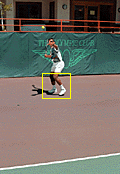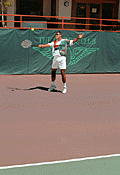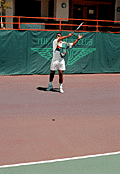|
TennisOne Lessons

The Defensive Forehand --
Stay in the Point and Bide Your Time
Nigel O'Rourke - Head Professional, Olympic Club
Written by Jim McLennan, Senior Editor, TennisONE
Photographs by Steve Margheim
Winning tennis means intelligent shot selection; i.e., selecting
the correct shot for a given situation. As a general rule, on a
weak second serve, select a heavy and penetrating return of serve (see O'Rourke's
return of serve lesson); for a weak shot hit short and slightly to your
backhand side, run around the backhand and drive the inside out forehand
from the pocket (see Patton lesson).
But obviously tennis is not all offense. In many instances, you must throw
up a lob and patiently work your way back into the point to gain valuable
recovery time. This lesson addresses one key shot in your defensive
arsenal: the defensive forehand.
The situation is this: you're in a neutral rally and suddenly your opponent
plays a ball high and deep, not really a lob, but truly a moon ball--a deep,
high bouncing ball. What do you do? The answer is to be found in the
following rhyme: drive the drive, drop the drop shot, lob the lob, and in
this case, moon the moon. In this case, the best reply is a high
arcing ball with topspin--or another moon ball. This shot will allow plenty
of time to recover and equally important, will create the identical problem
for your opponent that you just faced.
Consider why a moon ball that drives you deep behind the baseline is a problem.
A drop shot from this deep position would be disastrous. Don't try it and
if you do, never tell anyone you tried. The moon ball's high bounce (above
the shoulder) makes it difficult to drive the ball with power and with an
adequate margin of safety. In addition, from this far behind the baseline
your opponent has time to easily retrieve nearly any drive you hit, and
at the same time, the speed of the drive will reduce your recovery time.
So moon the moon, or lob the lob as it were.
Look below to see how Nigel O'Rourke below handles the moon ball. Notice
that his weight is balanced. His legs are bent so he's ready to come under
the ball and lift it. This is an obvious tip for the upcoming topspin. In
the second frame he has opened his shoulders, let the arm and racquet swing
out and up. Note the ball is well away rather than in tight and cramped.
Finally the follow through continues up and moves over his shoulder. This
is not power topspin but rather a gentle, rolling of the high and deep groundstroke.
Also note the position of the head throughout the swing is picture perfect:
he is focused on the ball before and at impact and on the follow through
his head has yet to move.
Tips to remember in the defensive mode:
- Be willing to give ground, its OK to back up as long as you
select the correct shot
- Moon the moon
- Use this shot to create ample recovery time
 

|
|
|